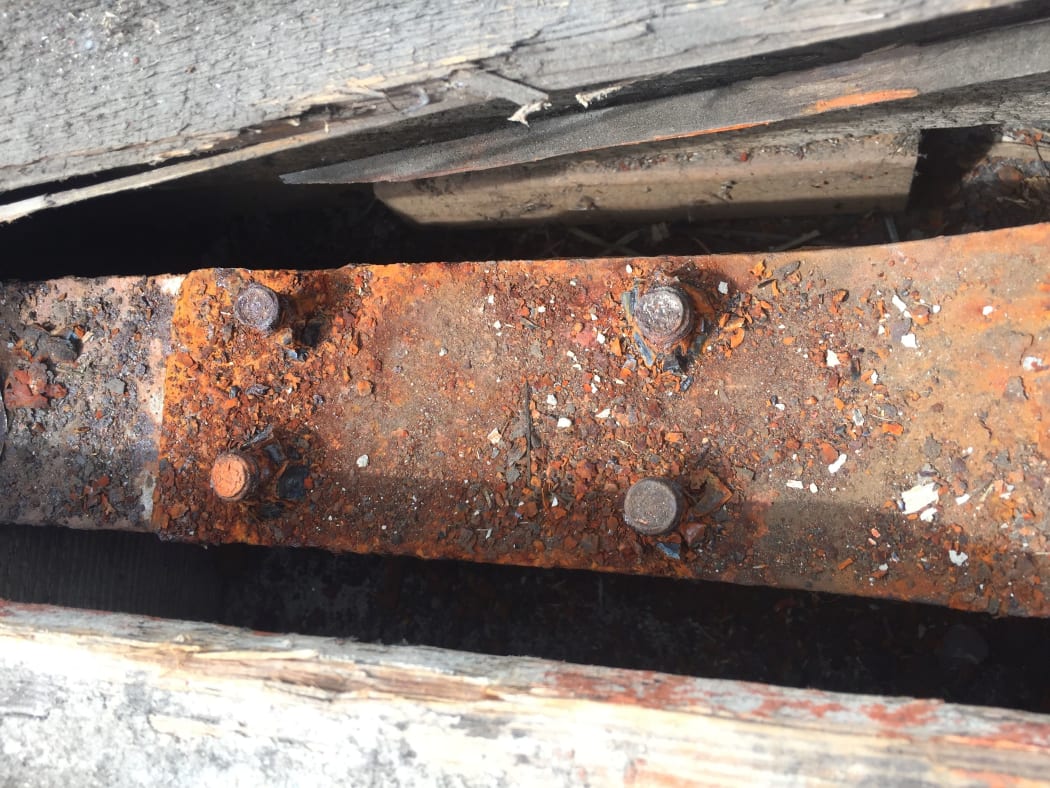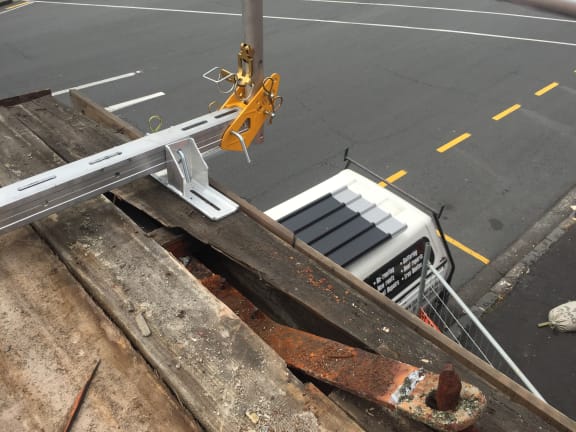Shop canopies so unsafe they could fall on pedestrians causing injury or death are a nationwide hazard, according to a steel frame engineering company.

Only part of one nut remained, with the other three rusted off entirely, on this 1 tonne shop canopy in Auckland. Tony Black's firm fixed it last week but he said there were many more like it. Photo: Supplied / Black Steel Mobile
Tony Black, managing director of Black Steel Mobile in Albany, said he was called out to fix a 1-tonne canopy in an Auckland shopping area.
"When we got there we found, on one of the fixtures, three of the four bolts that held the beam up above the footpath ... had rusted completely away.
"There was absolutely no trace of nuts on three of the bolts, and the other remaining one ... there might have been 50 percent of half of one side of the nut still remaining, and that was all that was holding it up.
"One bump, anything could've made that collapse."
Mr Black would not identify the particular building or suburb.
He said the owner, alerted by roofers to the rusted bolts hidden beneath the old roofing steel, got it fixed immediately.
However, some building owners wanted a half-baked repair, Mr Black said.

This owner got the canopy properly fixed immediately, but that's not always the case said Mr Black. Photo: Supplied / Black Steel Mobile
Also last week he was asked to fix isolated parts of a rusty canopy holding up shop signs on another building, but refused.
"In my experience that's not a very good option because it was made out of hollow steel, so we can't see the inside of the steel.
"They should've replaced the whole lot - if it wasn't strong enough to hold the signs up, it's not strong enough to be above the footpath."
He was not trying to drum up business, he said, adding his two-decade-old company had too much work as it was, dealing with 70 tonnes of house framing a week. He wanted to raise the issue of what he believed was a widespread risk in response RNZ's reporting about substandard earthquake restraints.

Canopies are not among the 16 specified systems that building warrant of fitness inspections cover. Photo: Supplied / Black Steel Mobile
People weren't thinking about the risk of canopies, he said.
"This would be completely right throughout the whole country ... My manager also agrees that many verandas in the country would be in similar condition."
Association of Building Compliance chairman Ron Green said canopies were not among the 16 specified systems covered by building warrants of fitness so inspectors did not check them.
"People think that the building warrant of fitness covers everything in the building ... there's a misconception it means their building is perfect in every aspect."
Balconies were not inspected either, though they used to be.
The Ministry for Business, Innovation and Employment exempted railings and balustrades from WOF inspections - which Mr Green said was to cut down on costs for building owners. "It was an item that we believe shouldn't have come off."
Just a fortnight ago, four men fell two metres onto a path after a railing gave way on a deck at the Portage Resort Hotel in the Marlborough Sounds. WorkSafe is investigating that incident.
Mr Black said both Auckland Council and independent inspectors should be checking on canopies as part of the WOF checks. In the absence of an official inspection regime for canopies it was up to owners and tenants to be vigilant but this was not happening "because of economics", he said.
The Auckland Council said building owners were responsible for maintaining canopies because they were not a specified safety system, so were not part of the building warrant of fitness regime.
The Ministry for Business, Innovation and Employment said balustrades, stairs, balconies and similar railings have never been included in building WOF checks in their own right.
However, safety barriers used to be checked at buildings with fire systems, but this was removed in 2005 because the barriers are now considered secondary structural elements that are up to building owners to check.


